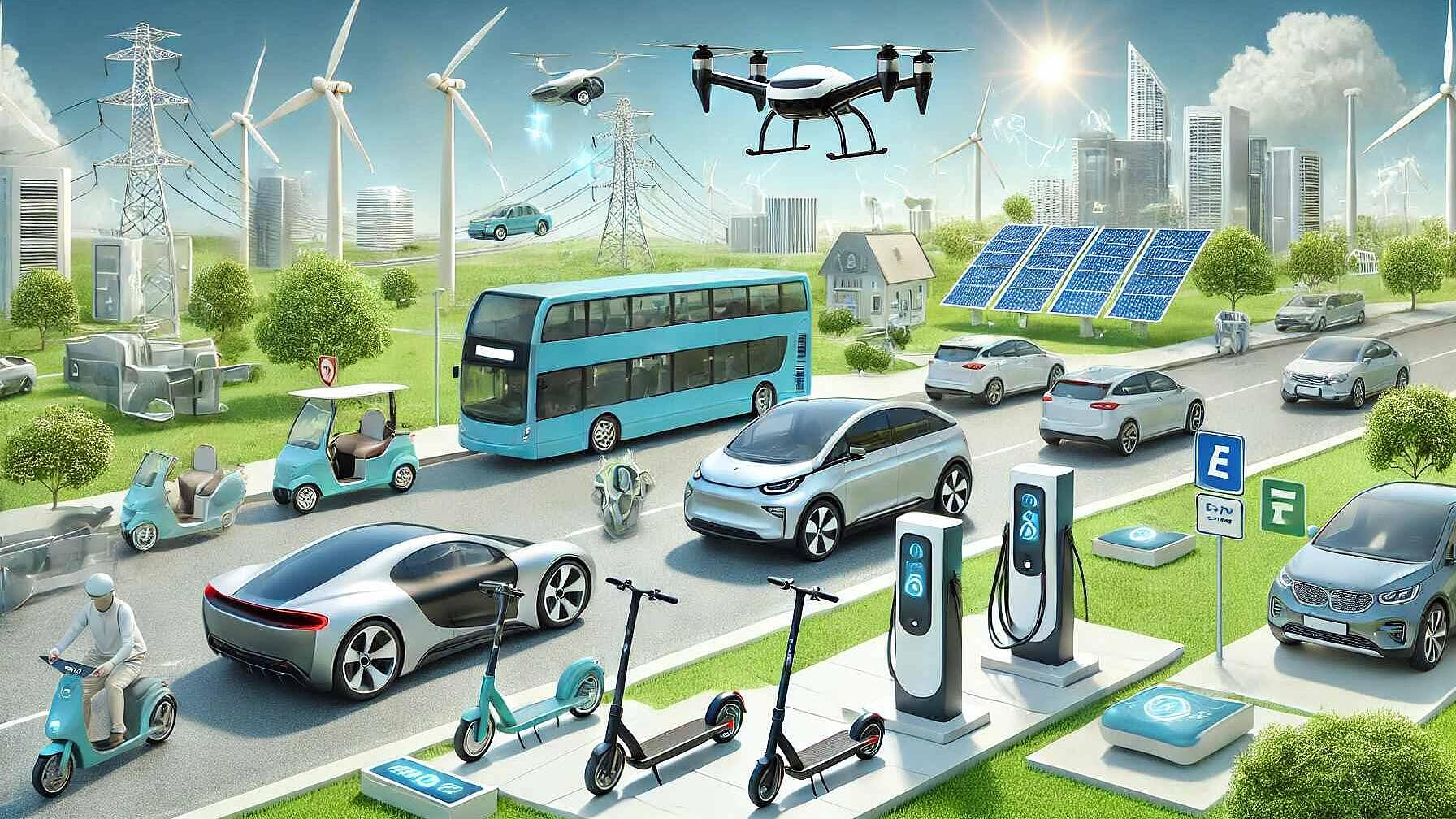 Renewable Energy
Renewable EnergyEV Revolution: Transforming Global Mobility Through Innovation and Accessibility
Summary
In 2024, global electric vehicle (EV) sales reached over 17 million, accounting for more than 20% of all new cars sold, with China dominating the market. China's EVs comprised nearly half of its car sales, while emerging markets in Asia and Latin America also saw remarkable sales growth, with electric car sales increasing by 60% and 50%, respectively, in 2024. Brazil's sales more than doubled, and even Africa experienced significant growth, particularly in Egypt and Morocco.
Affordability has been a key driver of this expansion, with global average EV prices decreasing. While EVs in Germany and the United States remained more expensive than conventional cars, in China, two-thirds of EVs sold were cheaper than their conventional counterparts. Battery technology and cost reductions have contributed to improved EV affordability, with the most significant price declines in China.
Advances in battery technology have also revolutionized charging capabilities, with batteries now able to charge a significant portion of their capacity in just minutes. Charging infrastructure has expanded globally, doubling the number of public charging stations since 2022. However, the presence and capacity of chargers vary by region.
In the commercial sector, electric trucks sales grew substantially in 2024, with total cost of ownership in China being lower for electric compared to diesel trucks in certain cases, indicating an economic incentive for adoption.
Looking ahead, EV sales are projected to continue growing, with a dramatic increase in market share expected by 2030. China remains the leader, with EVs expected to represent 80% of its total car sales by 2030. Europe and Southeast Asia show strong growth potential as well, with significant policy support and manufacturing capacity.
The global transition to electric mobility is anticipated to displace over 5 million barrels of oil per day by 2030, highlighting the important implications for energy security and environmental impact. The trend signifies a major transformation in transportation, emphasizing the economic and environmental benefits of early adoption.
Open full article
EV Revolution: Transforming Global Mobility Through Innovation and Accessibility
The global electric vehicle (EV) landscape has transformed dramatically, with 2024 marking a watershed moment as EV sales exceeded 17 million worldwide—representing over 20% of all new cars sold. This milestone isn't just a number; it represents more than the total EV sales recorded in 2020. At the heart of this revolution is China, where electric cars now account for almost half of all car sales, with over 11 million electric cars sold in 2024 alone—more than global sales just two years prior.
The ripple effects of this transformation extend far beyond established markets. Emerging markets across Asia and Latin America have emerged as new growth centers, with electric car sales jumping by over 60% in 2024 to reach nearly 600,000 units—equivalent to the European market five years ago. In Southeast Asia specifically, electric car sales grew by nearly 50% to represent 9% of all car sales in the region, with Thailand and Vietnam showing particularly strong adoption.
Brazil, the largest car market in Latin America, witnessed a remarkable surge, with electric car sales more than doubling to 125,000 in 2024, reaching a market share exceeding 6%. Even Africa, though starting from a lower base, saw electric car sales more than double, primarily driven by growth in Egypt and Morocco.
Price Competitiveness: The Game-Changer
A critical factor driving this expansion is affordability. As a global average, electric car prices fell in 2024, though purchase price gaps with conventional vehicles persisted in many markets. The regional differences tell an interesting story: in Germany, the average battery electric car remained 20% more expensive than conventional counterparts, while in the United States, the premium was even higher at 30%.
China presents a striking contrast: two-thirds of all electric cars sold in 2024 were priced lower than their conventional equivalents, even without considering purchase incentives. This price advantage has been instrumental in boosting sales despite decreasing government incentives.
The competitive edge of Chinese manufacturers is particularly evident in emerging markets. In Thailand, the average price of a battery electric car has reached parity with conventional cars, with Chinese models typically available at even lower price points. Similarly, Brazil saw the price gap between battery electric and conventional cars shrink to 25% in 2024 from over 100% in 2023, largely due to Chinese electric car imports accounting for 85% of the country's EV sales.
The Battery Revolution
Battery technology advances and cost reductions have been fundamental to improving EV affordability. Low critical mineral prices and increasing competition between battery manufacturers drove down battery pack prices across all markets in 2024, though at varying rates. Most notably, prices fell by about 30% in China, compared with 10-15% in Europe and the United States.
The faster pace of cost reductions in China stems from several factors: strong competition, increasing manufacturing efficiency, supply chain integration, and access to a skilled workforce. This has further enhanced the competitive advantage of Chinese battery manufacturers.
Recent innovations are also reshaping the charging landscape. Battery technology breakthroughs now enable safety during high-power charging that could make the process nearly as quick as refueling a conventional car. For instance, CATL launched the Shenxing battery, which can charge about 30% of capacity in just 5 minutes, providing 200 km of additional range. In 2024, they released an improved version offering similar energy density but faster charging speeds in collaboration with SAIC-GM, allowing to recharge over 40% of the battery capacity in 5 minutes.
Even more impressive, in March 2025, BYD set a new benchmark with its Super-e platform, claimed to deliver around 400 km of range in just 5 minutes. This leap was made possible by next-generation silicon carbide power chips, all-liquid-cooling, and a 1,000 V architecture, which allows for coupling with 1 MW charging.
Charging Infrastructure: The Backbone of EV Adoption
The expansion of charging infrastructure has been keeping pace with growing EV adoption. Public charging stations have doubled since 2022 to reach more than 5 million globally. China and the European Union have been particularly effective in maintaining a steady deployment rate relative to the number of EVs on their roads.
The capacity of public chargers is becoming as important as their quantity. Ultra-fast chargers with power ratings of 150 kilowatts and above grew by about 50% in 2024 and now account for nearly 10% of all public fast chargers. These high-capacity chargers are critical for enabling long-distance travel and reducing range anxiety.
Highway coverage also varies significantly across regions. In Europe, over three-quarters of all highways have a fast-charging station at least every 50 kilometers, compared with less than half of US highways. This infrastructure disparity affects consumer confidence and convenience in different markets.
Looking ahead, public charging capacity for light-duty EVs would need to grow by almost ninefold by 2030 to support EV sales implied by stated policies. Even with this significant expansion, EVs are projected to account for only 2.5% of total global electricity demand in 2030.
Commercial Transport: Electric Trucks Gaining Momentum
The electrification wave is extending beyond passenger vehicles to commercial transport. Electric truck sales grew by nearly 80% globally in 2024 to reach close to 2% of total truck sales. China led this growth, with truck sales doubling to 75,000 vehicles, representing over 80% of global sales in 2024, spurred by a new scrappage scheme for conventional trucks.
The economic case for electric trucks is strengthening. The total cost of ownership of a battery electric heavy-duty truck is already lower than for a diesel equivalent in China in certain cases. While the purchase price remains two to three times higher than equivalent diesel trucks in major markets, greater efficiency and lower energy costs make battery electric trucks more attractive the more they are used.
By 2030, battery electric trucks in Europe and the United States are expected to reach parity on the total cost of ownership with diesel trucks for long-haul operations, as they already have in China. This economic shift will likely accelerate adoption in the commercial sector.
The Road Ahead: Projections and Opportunities
Looking forward, electric car sales in 2025 are expected to exceed 20 million worldwide, representing more than one-quarter of cars sold globally. Despite uncertainties in the outlook, the share of electric cars in overall car sales is projected to exceed 40% in 2030 under today's policy settings.
China will continue to lead, with electric cars expected to reach around 80% of total car sales by 2030, driven by significant market momentum and competitively-priced EVs. In Europe, carbon dioxide targets support the achievement of a sales share of close to 60% by 2030.
In Southeast Asia, electric car sales are boosted by strong policy support and available domestic manufacturing capacity, with one in four cars sold in the region projected to be electric by 2030. Two/three-wheelers are electrifying even faster in the region, with almost 1 in 3 such vehicles sold expected to be electric by 2030.
Conclusion: The Transformative Power of Electric Mobility
The global shift to electric mobility represents more than just a change in powertrain technology—it signifies a fundamental transformation of transportation systems worldwide. With falling battery prices, expanding charging networks, and increasingly favorable economics, EVs are moving from niche to mainstream across diverse markets.
China's leadership in manufacturing and affordability has been instrumental in accelerating global adoption, particularly in emerging markets. Meanwhile, technological innovations continue to address key consumer concerns around charging time and range.
As we look toward 2030, the momentum behind electric vehicles appears unstoppable. The projected displacement of over 5 million barrels of oil per day globally by that time underscores the significant energy security and environmental implications of this transition.
For consumers, businesses, and policymakers alike, the message is clear: the future of mobility is electric, and that future is arriving faster than many anticipated. Those who embrace this transformation early stand to benefit from lower operating costs, reduced emissions, and leadership in one of the 21st century's most significant industrial shifts.
Source: IEA Global EV Outlook 2025



